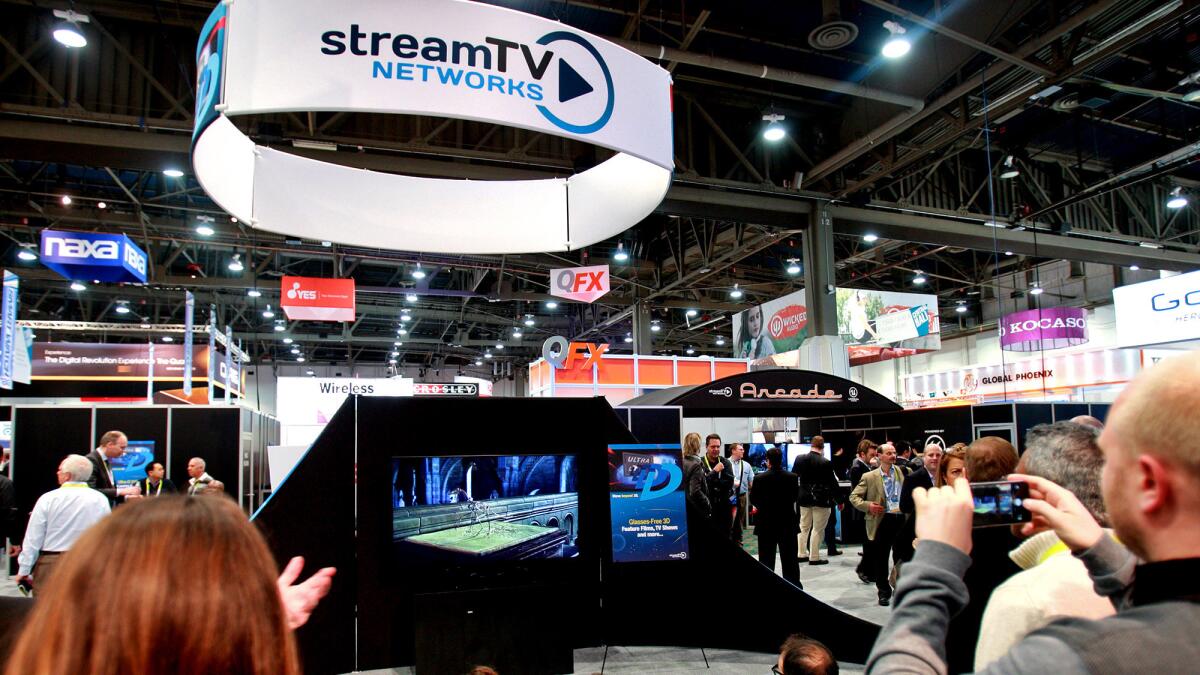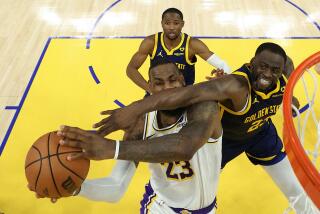New hardware and software aim to make TV and Internet work together

- Share via
Nobody knows what “television” means anymore. Videos, from homemade snippets to full-length TV shows and movies, dominate traffic over the Internet, beamed to smartphones, tablets, phablets, laptops, desktops and soon on tiny screens worn around the wrist. Oh, on regular TV sets too.
Meantime, cable companies try to keep customers from defecting while they come to terms with new technology, and broadcast TV struggles to remain relevant.
It’s a bit of a mess. And as the Internet and TV converge, there’s a flood of hardware and software being pumped out that doesn’t always work together, as each manufacturer and software makers fights to make its approach the dominant one.
So while trade shows like this week’s Consumer Electronics Show in Las Vegas are loaded with cool stuff, it’s unclear how it’s all going to come together.
“There’s so many screens now and people want to view their content in a short, fast way on these screens,” said TV personality Nick Cannon, the convention’s entertainment industry ambassador. “Two fast-moving industries — tech and entertainment — have got to continue talking the same language.”
Even if they talk the same language, it doesn’t mean that consumers will understand.
As TV networks continue to debate how to price and distribute their content online, several start-ups whose apps are designed to simplify the process of organizing media files or finding streaming content used CES to introduce updates that make even more content accessible. It remains to be seen whether their efforts will clarify or further confuse the issue.
PlayOn, which records online videos for later viewing while stripping ads, unveiled a revamped computer app for those cutting the cord on cable TV. The updated interface gives users a neatly designed command center to build a library of TV programming without a traditional cable or satellite subscription. Everything comes from content that networks have made available on different corners of the Web such as Hulu or CBS.com.
ChannelMaster’s traditional set-top DVR box will soon bring in online channels as well. Videos posted to the Web by Bloomberg and AnimalPlanet appeared on the same channel guide as the networks’ traditional cable channels.
Tablo, a service for recording over-the-air channels, released its first set-top box with a built-in antenna. It’s plug-in-and-play for $250, saving the time of setting up an antenna. The company also announced plans to release apps for the Roku and Amazon Fire TV consoles as well as Android TV-equipped devices.
NBCUniversal’s offered a sample of what’s to come as more of the industry gets its hands on Web-connected home appliances. When using the Syfy app while the show is on TV, the upcoming series “12 Monkeys” illuminates Philips Hue smart light bulbs in a home to match the emotion and lighting of scenes in the show.
“You wonder during production what that final playback in a home in Middle America will be like,” said series co-creator Travis Fickett, who saw the setup in action for the first time Tuesday night. “With this, you know, they are going to be totally immersed in the show. “
NBCUniversal also showcased its recently released fitness app called Radius. Essentially a $9.99-a-month Netflix for workout videos, Radius is a big leap forward in terms of personalizing fitness programming previously relegated to expensive, static DVDs, said Nick Lehman, president of digital at NBCUniversal.
Content from the app is being promoted on a morning TV show on NBC Sports Network and across the rest of the broadcast family. It will also soon be available on Comcast set-top boxes.
“We give them a taste on television and hope they subscribe to the service to get the full meal,” Lehman sad.
He said the company is treating Radius like a start-up, using it as a test case for building new businesses within NBC. Early on, they realized they had to be integrated in as many devices and mediums as they could from inside a reality TV show to tying it up to wearables.
“You got to get the basic pillars out there from the beginning because consumers are going to want to use everything,” Lehman said. “There’s not many platforms you can neglect at this point.”
How consumers receive and pay for video has been among the hot topics this week at CES after Dish Network on Monday announced an online TV subscription service called Sling Television, headlined by Walt Disney Co.’s ESPN.
“We’re clearly very excited to experiment and I’m almost certain this isn’t the last experiment you’ll see on the packaging, pricing and distribution front,” Disney Chief Financial Officer Jay Rasulo told The Times late Wednesday.
3-D is getting a lot of attention at CES too, even though Hollywood’s attempt to gain more revenue from 3-D movies is lagging behind expectations and the market for 3-D television sets is a flop.
The latest near-market 3-D technology is focusing on eliminating the need to wear special glasses or use special DVD players to watch 3-D content.
SuperD Technology Co. unveiled a hand-held concept device for glasses-free 3-D that pops open like a clamshell. Using Bluetooth or Wi-Fi, it grabs content from a mobile device and plays it on a screen that reflects light in a way that makes the content look almost like a hologram.
The 10-year-old Chinese company, with a new branch in Santa Clara, is already selling its glasses-free 3-D displays to makers of smartphones, tablets and arcade games. Smartphones from InFocus and Snail Mobile set to launch in China this spring are equipped with built-in cameras that track a viewers’ eyes to keep the 3-D content looking the way it’s supposed to even when the phone is held at odd angles.
“The technology is there and the product is there,” SuperD President Michael Hsu said. “We’re coming to the U.S. to work with Silicon Valley, to work with Hollywood, to see how can we create one-stop shopping for 3-D content.”
The gadgets with SuperD, along with several television sets expected to include a technology called Ultra-D, are aimed at making 3-D content as easy to access and view as anything else. For example, Stream TV Networks’ Ultra-D is a chip that sits inside a television and automatically turns any 2-D stream into 3-D, viewable without special glasses.
“When you see a field goal or extra point in glasses-free 3-D while watching ESPN, it’s just amazing,” Stream TV Chief Executive Mathu Rajan said.
Twitter: @peard33
More to Read
Inside the business of entertainment
The Wide Shot brings you news, analysis and insights on everything from streaming wars to production — and what it all means for the future.
You may occasionally receive promotional content from the Los Angeles Times.











